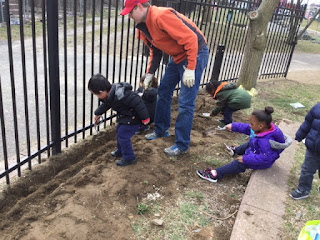There was a lot happening in this very short week of school!
On Wednesday we prepared egg dyes and each child dyed an egg in the color of their choice.
 |
| A new science material - sorting natural & human-made materials |
 |
| Enthusiastic samplers for dragon fruit! |
 |
| A new collage work choice on the art shelf - adding cherry blossoms to the tree branches |
Springtime
We’ve watched the
daffodils in front of the school progress over the past few weeks and were
excited to see the first few flowers open last week. We have read books about
daffodils (“That’s not a Daffodil!” by Elizabeth Honey & “The Bulb: See How it Grows by Pamela Nash) and
examined the bulbs of onion, garlic, and flowers. This week the children helped
plant some flower bulbs in the park.
The children enjoy this silly poem where we imagine that the
daffodil is a person.
by A.A. Milne
She
wore her yellow sunbonnet;
She
wore her greenest gown
She
turned to the south wind
And
curtsied up and down
She
turned to the sunlight
And
shook her yellow head
And
whispered to her neighbor,
“Winter
is dead!”
Lent & Easter
We
have heard several bible stories during lent. We often tell a simple version of
the story, focusing on the most important details and the aspects that children
can relate to. Children readily understand emotions, so we sometimes pause to
discuss what the characters might be feeling.
In past weeks
we heard about Jesus healing Bartimaeus of blindness and Zaccheus of greed
& loneliness.
This
week began with Jesus riding into the city of Jerusalem on a donkey. Many
people welcomed him with palm branches, hoping Jesus would become their new
king and throw out their mean, unfair rulers. Instead of a big, fancy horse
like a king would ride, Jesus chose a donkey. We looked at a photo comparing a
donkey and horse, and then had our own processional with palm branches.
Pennies for Peace
We have a jar of coins in
the classroom. You can continue collecting at home and bring in the coins after
Easter. Let us know if you need a replacement penny collector!























